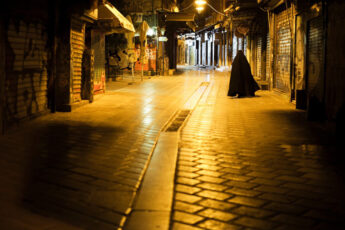Another Festival Headache Film
Alexandros Voulgaris’ They Come Out of Margo (Vgainoun mesa ap ti Margo, 2025)
Vol. 158 (October 2025) by Anna Batori
Some films seem destined to be used in film schools – not as models of excellence, but as cautionary examples of how not to make a film. They Come Out of Margo fits squarely into this category. It’s the kind of film that leaves viewers wondering how it found its way into the Karlovy Vary International Film Festival. Perhaps the selection committee included it as a lesson in cinematic missteps – a case study in what to avoid.
The film ostensibly follows the story of Margo (Sofia Kokkali), a successful musician whose sister was murdered during her childhood. Now living with Rhea (Evi Saolidou) and a loosely defined commune of others who alternately sing, dance, or stare blankly into the void, Margo’s world unfolds with little discernible plot – if one exists at all. The film mainly depicts Margo’s friends walking around the apartment, singing, glancing at the camera, and performing monologues that are nonsensical. To make matters worse (and yes, they do get worse), Voulgaris experiments with a pseudo-Švankmajerian style that includes photo-shoot-like freeze frames, erratic saturation shifts, and experimental imagery where the camera cable intrudes into the frame or the image’s lower half is inexplicably obscured. Although, to be honest, it is more likely a technical failure than an experimental gesture.
The already incoherent narrative is further undermined by relentless handheld camera work, resulting in what may be the most visually chaotic film of the year. One particularly confounding scene features a man standing in a white hallway. He begins violently banging his head against the door while a young girl plays the piano inside the apartment. The soundtrack layers in eerie ambient noise and inexplicable cat-like yowling – despite the only visible animal being a dog. The scene culminates with the man’s face covered in blood and bruises, after which the characters declare he must have “come out of Margo.”
It appears that Margo is somehow giving birth to these people – though I must admit, this explanation comes not from the film itself, but from the press release. The narrative vaguely gestures toward a generational curse involving a demon in Egypt, yet without this extra-textual information, the film’s endless philosophical monologues and cryptic musings about life and individuals “emerging from Margo” would remain utterly unintelligible.
Voulgaris clearly attempts to emulate the aesthetic of the Greek New Wave – marked by stilted communication, emotionally vacant relationships, and robotic dialogue delivery. However, the absence of narrative logic, causal structure, or any coherent story renders the performances unintentionally comical. Even the usually outstanding Sofia Kokkali is reduced to a self-parody. It’s difficult not to laugh when the characters break into painfully off-key singing, or when a potted plant arrives inexplicably sprouting a chunk of raw meat from its soil.
Why the film is categorized as “horror” in its press materials remains a mystery – though perhaps not entirely, given the direction much of the European festival circuit seems to be heading. I’ve long predicted the rise of what I call “wannabe art films”: productions that adopt superficial markers of body horror or surrealism in an attempt to appear edgy, enigmatic, and festival-ready. They Come Out of Margo is perhaps the worst offender to date – a film that borders on viewer abuse, yet offers unexpected relief in its final moments, when the end credits roll and one is finally released from the ordeal. That, truly, may be the best moment it delivers.




Leave a Comment